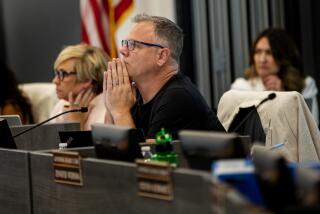Mission Viejo Recall War to Climax Today : Politics: Voters will cast ballots on whether to remove a councilman. He calls members of the council majority toadies of the company that built the community.
- Share via
Little in Mission Viejo’s brief history prepared it for the venom that has accompanied the effort to recall City Councilman Robert A. Curtis.
In the Orange County community’s first two decades of development, most issues were handled quietly, shepherded by the Mission Viejo Co. and a cadre of community loyalists.
But after Mission Viejo’s incorporation in 1988, even the most routine proposals have cleaved the City Council and sparked long sessions of shrill name-calling. More often than not, the outspoken Curtis has been at the center of those battles, earning him passionate admirers and equally vocal foes.
Curtis’ opponents call him a “liar,” and he shows little restraint in blasting back. He has referred to the three-member council majority as “the three stooges” and he accuses them of toadying to the Mission Viejo Co., which built the community and is the major financial backer of the recall effort.
After months of bitter campaigning by both sides, Mission Viejo residents today will try to settle the differences once and for all, voting on the recall and on Measure A, which would require large annexation proposals to go before city voters.
Tempers have flared so hotly over the recall issue that Mayor Christian W. Keena, a Curtis foe, has received half a dozen death threats in the closing weeks of the recall campaign, he said. He has changed his home phone number, and sheriff’s deputies have had to check his car and neighborhood for bombs.
“It’s been unbelievable,” Keena said. “It’s absolutely insane.”
As tensions have grown, much of the debate has coalesced around a single issue: whether the Mission Viejo Co. has overstepped its bounds in governing the community it created.
Curtis, a 34-year-old lawyer, vehemently attacks the company, asserting that it meddles in issues better left to residents. The company and its supporters retort that it is out of concern for the community that the Mission Viejo Co. takes an active interest in local affairs.
“We have some parallel interests with the Mission Viejo Co.,” said Helen Monroe, who chairs the pro-recall Alliance for Mission Viejo. “The company has an interest in this city, and so do we. We both want to see the plan for this community completed without Bob Curtis interfering with it.”
That common ground has manifested itself in enormous financial support for the recall effort, which so far has garnered $470,000 in contributions, $267,000 of which has been contributed by the Mission Viejo Co. By comparison, Curtis has raised about $39,000. “Those strike me as very big numbers for a recall campaign, both in terms of total contributions and in terms of contributions from a single source,” said John Larsen, chairman of the state Fair Political Practices Commission. “I can’t think of campaigns I know of that rival it.”
Curtis is more blunt. “It’s obscene,” he said. “They’re trying to buy this city.”
Monroe said she sees no problem with accepting the huge donations or other support that the Mission Viejo Co. provides.
“They have offered us support and we have accepted it,” Monroe said. “We are not tools of the company, though, no matter what Bob Curtis says. . . . He lies about so many things it doesn’t matter what he says.”
The animosity between recall proponents and Curtis is both deep and personal, dating back even before Curtis won his seat on the council in 1988. During that campaign, Curtis and William S. Craycraft, who would later become mayor, distributed a hard-hitting mailer as Election Day approached. The mailer attacked the community’s advisory governing body, accusing it of mismanagement of area parks and park fees. Council candidates Victoria C. Jaffe, Norman P. Murray and Keena were members of that body, and the mailer marked a break from the community’s relatively benign politics.
“It was a hit piece, nothing more,” Jaffe said later.
Although all five were elected to the council, the tension that sprung from that salvo has never really subsided. Even today, the council majority--Jaffe, Murray and Keena--repeatedly alludes to the mailer, which it and others see as evidence that Curtis and Craycraft have their eyes on higher political office and that their hearts are not really in Mission Viejo.
If that mailer laid the groundwork for the subsequent recall, it was a 1989 annexation fight that gave it life. Curtis, who had lived in a pie-shaped wedge of land bordering Mission Viejo known as Aegean Hills, championed the area’s annexation, saying it would supplement Mission Viejo’s tax base.
The Mission Viejo Co. strongly opposed the annexation, arguing that it would disrupt the community plan laid out for the community in the early 1960s.
Although the council first voted unanimously in favor of proceeding with the annexation, it reversed itself later, with the three-member majority voting against it, arguing that the economic picture was too uncertain to proceed. Curtis and Craycraft stood their ground, but it was Curtis, considered by critics to be the more divisive element, who became the target of the recall.
Curtis considers the company’s public devotion to the master plan a smoke screen, intentionally intended to divert attention from what he considers the central issue of the recall: His positions advocating controlled growth.
“The strong undercurrent of this campaign is the very real power struggle between the Mission Viejo Co. and slow-growth advocates,” he said. “My independence from the Mission Viejo Co. has led to this extremely divisive overkill.”
There again, debate ensues. Monroe and her allies say the recall is not responsible for dividing the community. They blame Curtis, who they point out is often brusque with speakers who approach the council during public meetings.
More to Read
Sign up for Essential California
The most important California stories and recommendations in your inbox every morning.
You may occasionally receive promotional content from the Los Angeles Times.













